Aquarium Kings – this is the name given to some of the most beautiful aquarium fish on the planet – discus (Symphysodon sp.). These fish immediately attract the eye due to their extremely unusual, almost round, body shape and enchanting coloration, especially in numerous breeds. The fish were called discus fish for their flattened, disk-like body.
General information
The genus name consists of two Greek words symphysis – “fused” and odon – “tooth”. And this is due to the peculiarity of the location of the four extreme teeth, located at the junction of the upper and lower jaws, one below the other. The name “Diskus” appeared a little later. This word in ancient Greece meant a flat throwing projectile for competition.
Discus has a certain specificity of keeping: stable water parameters, elevated temperature, the need for large volumes for keeping. They can be called extremely sensitive, which discourages many aquarists from keeping these adorable fish. The low immunity of discus is associated with their natural habitat. The water in the Amazon basin is very soft and acidic and contains a large number of tannins. In such water, the reproduction of microorganisms is difficult, therefore, discus is not able to properly respond to infections. Thus, a discus is recommended for keeping by experienced aquarists, who perfectly understand all the processes taking place in the aquarium.
Discus was first described by Australian scientist Johan Natterer during his next expedition to Brazil. It happened in 1833 after a specimen of a previously unknown fish was caught in the Rio Negro River. Johan Jacob Heckel made a great contribution to the study of discus, it was he who proposed the generic name Symphysodon.
The first live discus was introduced to Europe in the middle of the 20th century. Currently, thanks to the mass breeding of fish in special complexes, it is not difficult to buy them practically in any country. But it should be noted that the price of discus remains one of the highest. Especially when it comes to a rare color variation.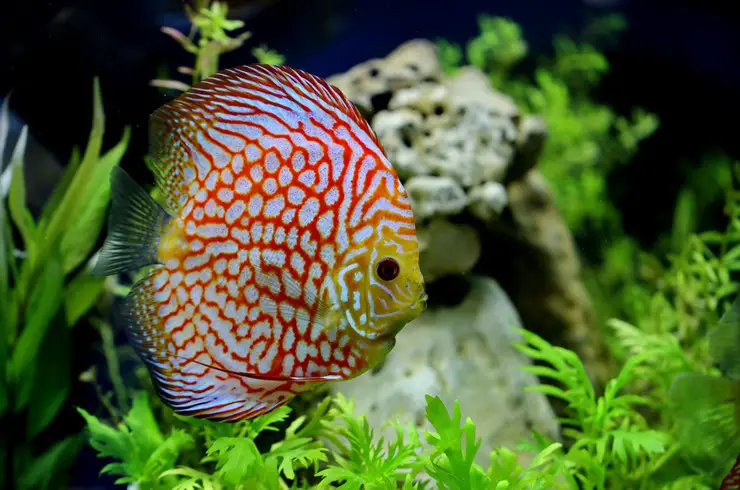
Appearance
The body of the discus has a disc-like shape and is very strongly compressed from the sides to the point that when observing the fish from the side of the caudal fin, one can see two eyes protruding from the sides of the head. These eyes are large and are located on a small head. The fins can be transparent or have colored spots in the same color as the body. The caudal fin is fan-shaped; the dorsal and anal fins run from head to tail. The pelvic fins are elongated. In the adult male discus, a distinctly prominent forehead can be observed. The color is extremely varied and depends on the specific species, but it is always effective. It can change depending on the state of the fish: colored stripes can appear or disappear all over the body. In an aquarium, discus can grow up to 25-30 cm.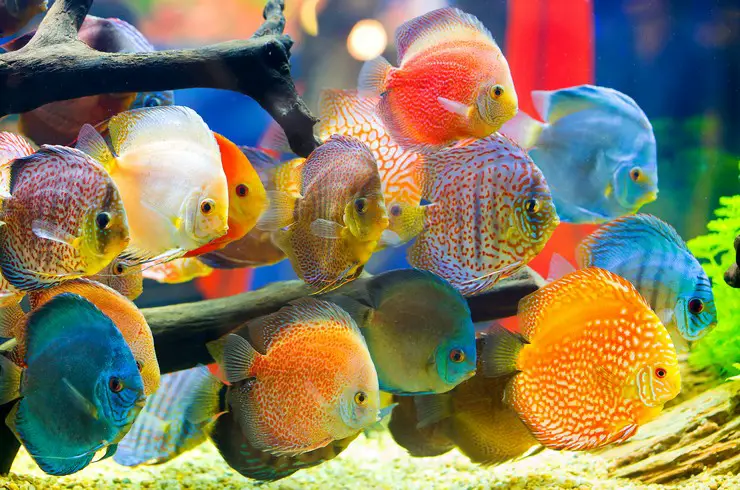
Habitat
The homeland of discus is the rivers of South America. They are found in the Amazon Basin. Therefore, discus can be found in countries such as Brazil, Colombia, Venezuela, and Peru.
The biotopes of the Amazon Basin are very interesting and can undergo significant changes. In December, the rainy season begins, which leads to flooding of rivers, as a result of which huge areas are flooded. Floods bring a lot of turbidities, and the previously crystal clear waters become like a swamp. After the end of the long rains, the water level drops, it becomes transparent again. Quiet backwaters appear everywhere, in which the water acquires a dark color (“black water”). In such isolated areas, the water is extremely soft and acidic. It is in such conditions that discuss lives in the wild. They prefer to stay closer to the coast, live in thickets of bushes. The bottom in such reservoirs is a thick layer of decaying leaf litter. Most of the life and spawning of fish takes place among the roots of coastal vegetation. It should be noted that it is very rare to find discus fish in large rivers; they prefer small streams and tributaries. As a result of this isolation, local color populations of discus fish have emerged, and we can observe a magnificent variety of colors of these amazing fish.
Kinds
The taxonomy of the discus has undergone certain changes during the study of the life of fish. At first, all discus were attributed to the same species, considering the differences in color to be only color variations. But a more detailed examination of the features of these fish led to the identification of three species within the genus Symphysodon.
- Red discus (Symphysodon discus)
This type of discus was the first to appear in hobbyist aquariums. In honor of the scientist who first described this species, it is often called the Heckel discus.
They live in South America, in the Amazon River Basin: in particular, in the Rio Negro, Rio Branco, and other rivers. They prefer water rich in humic substances, the so-called “black water”. The soil in natural biotopes is sandy with a large number of dying leaves.
The shape of the body is standard, disc-shaped, flattened laterally. The iris of the eyes is bright red. The body color of the Heckel discus ranges from reddish yellow to brown. Longitudinal wavy blue lines cross almost the entire body of the fish, except for the chest and middle of the body. There are nine vertical dark stripes on both sides of the flattened body, the first, fifth, and ninth stripes are most pronounced (brighter and wider). Depending on the condition of the fish, the color of the discs may vary.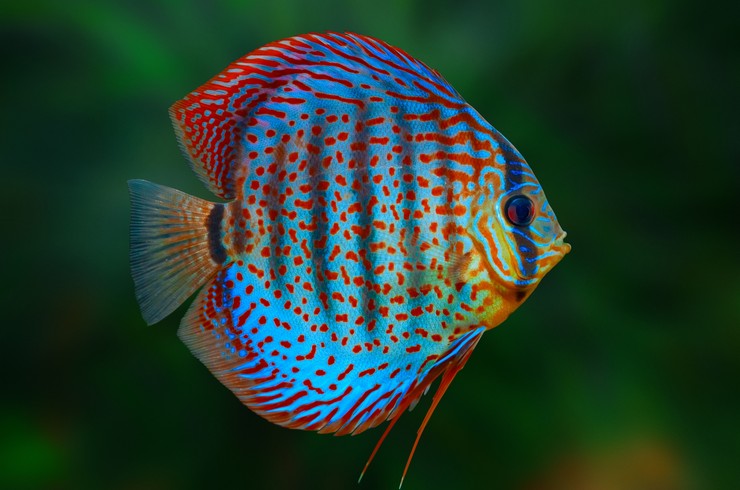
If the fish is agitated, the vertical lines practically disappear, but the blue ones become much brighter. In stressful situations or with poor content, everything happens exactly the opposite: the blue lines fade, and the vertical ones become more contrast. In especially advanced situations, an almost complete discus discoloration can be observed. In nature, it grows up to 20 cm, in aquariums, the size usually does not exceed 10-15 cm. Gender dimorphism is weakly expressed. The natural diet is based on zoo and phytoplankton, as well as detritus during dry periods.
- Green Discus (Symphysodon tarzoo)
Despite the fact that the main body color of the fish is brown-yellow when examining a fish caught in nature with a reflection of a blue sky, the scales appear greenish. The fish received a specific epithet in honor of the Colombian company from the city of Leticia, specializing in the export of fish. It was in its vicinity that Symphysodon tarzoo was caught and described. It should be noted that this group of discus received the status of a species relatively recently – in 2006, based on DNA analysis.
The green discus inhabits the Amazon River basin (Peru, Colombia, Brazil). They prefer black water. They live near the coast among sunken trees and dying leaf litter.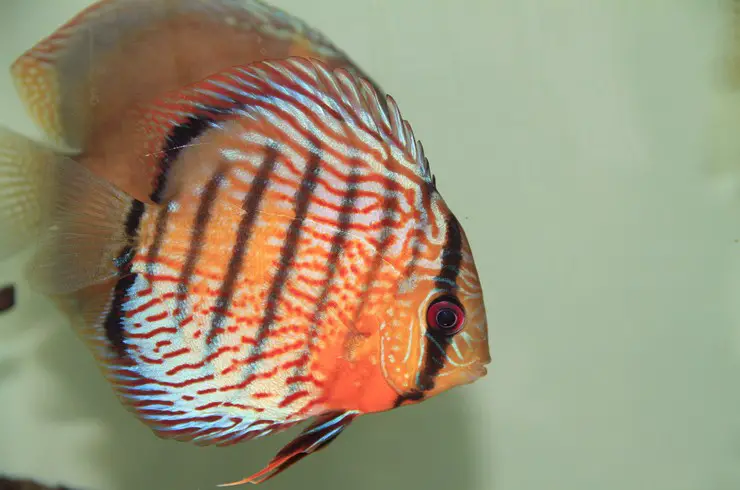
The iris is bright red. Longitudinal wavy lines of turquoise color run along the entire body and dorsal fin of the green discus. A wide black stripe runs along the dorsal fin. Morphologically, this type of discus differs from others by the presence of reddish dots on the body and fins, which appear in fish at the age of six months. Gender dimorphism is not pronounced. The average size of a green discus in an aquarium is 13 cm.
- Discus equidistant (Symphysodon aequifasciatus)
The Discus is inhabited in the basins of the Amazon and Rio Negro rivers. They prefer clear water. The length reaches 15 cm. The head and mouth are small. The body is disc-shaped, with a wavy pattern on it. The background color of the fish varies from brownish-yellow to red. Horizontal stripes are blue or greenish. A wide dark stripe runs along the dorsal and anal fin in a semicircle. Body-color may vary depending on the condition of the fish. Distinguishing a female discus from a male is quite problematic.
There are several subspecies of Symphysodon aequifasciatus with a characteristic coloration – brown and blue discus. Determining the exact type of discus in an aquarium is almost impossible due to the fact that many years of work by breeders have led to the appearance of a large number of color variations. Gender dimorphism in these fish is not expressed.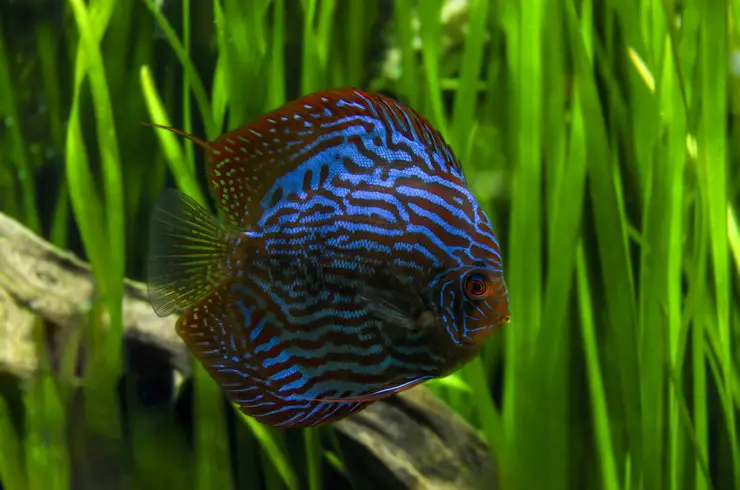
Care and maintenance
To keep discus, first of all, you need a spacious aquarium. The minimum volume for a small school of fish is 250 liters, but ideally, this should be an aquarium of 400 liters or more. The height of the water column is desirable about 50 cm since discus is a relatively tall fish in an adult state. When keeping discus fish, it is very important to provide peace of mind to pets. Fish are very shy and constant stress factors can lead to illness and even death. It is not recommended to set up an aquarium with discus in walk-through areas or near sources of strong sounds.
There are two main approaches to the interior of an aquarium when keeping discus. Some aquarists prefer the classic version – a herbal aquarium with soil and dense thickets of plants.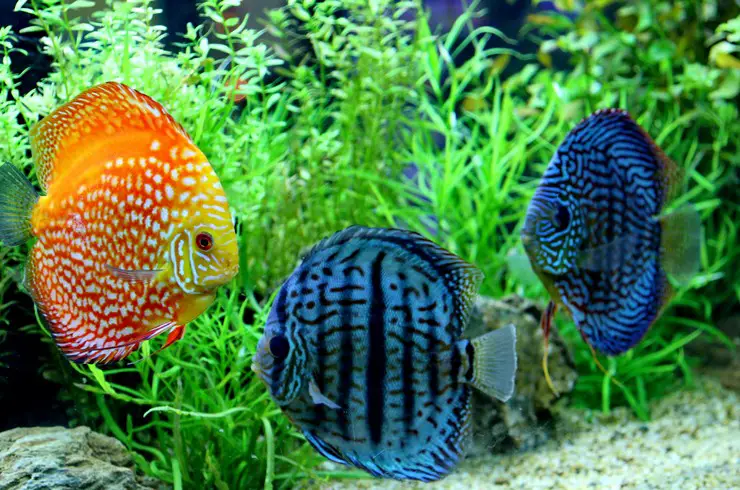
Others believe that discus does not need an additional background, and it is better to keep them in an aquarium without soil, plants, and decorations. The latter point of view is more practical and is associated with the fact that, firstly, it is difficult to find plants that can withstand the optimal temperature for discus (27-30 ° C). Secondly, any dying organic matter in the aquarium is a potential source of nitrogenous compounds, to the content of which the discus are very sensitive.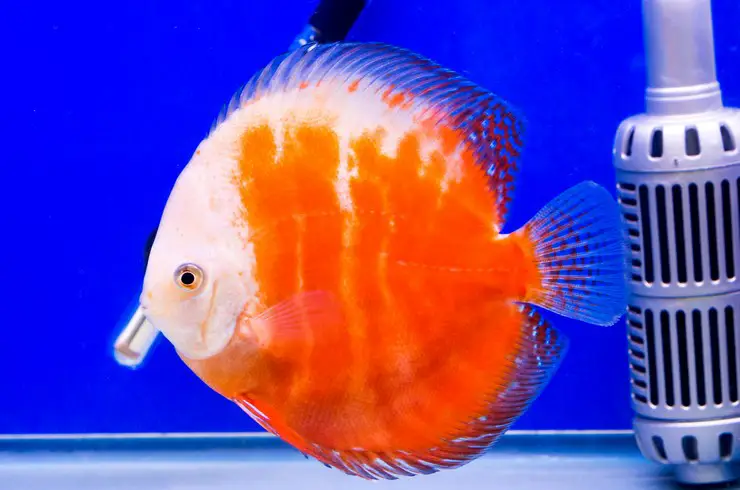
On the other hand, a herbal tank with discus looks much more spectacular, and live plants help maintain the biological balance in the aquarium. The most important thing is careful maintenance, the supply of carbon dioxide, high-quality lighting.
Discus does not tolerate any fluctuations in water parameters. The more stable the environment, the less likely these fish are sick. Discus are extremely thermophilic: the optimum temperature is 27-30 ° C. The water should be acidic and soft, close to that in nature. pH = 5.5 – 6.5, hardness – 1 to 12 ° dGH.
The aquarium should be provided with high-quality filtration (powerful external filter or even several) and aeration. An increase in the content of nitrates in water above 25 g / l must not be allowed. Discus are very sensitive to the concentration of nitrogenous compounds, and exceeding the norm can cause stress. A weekly change of up to ¼ of the aquarium water is required. Although there is a recommendation that it is advisable to do a daily water change of 10-20%. In this case, each aquarist decides for himself how best to proceed. The main thing is to regularly test the water for basic parameters and prevent their sudden jumps. With good care, discus can live in an aquarium for 10 to 18 years.
